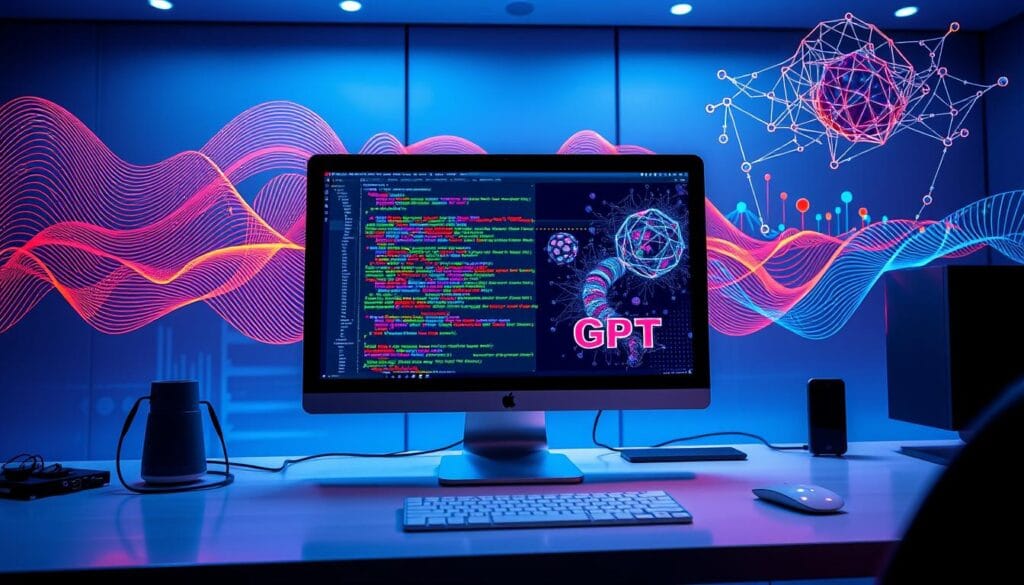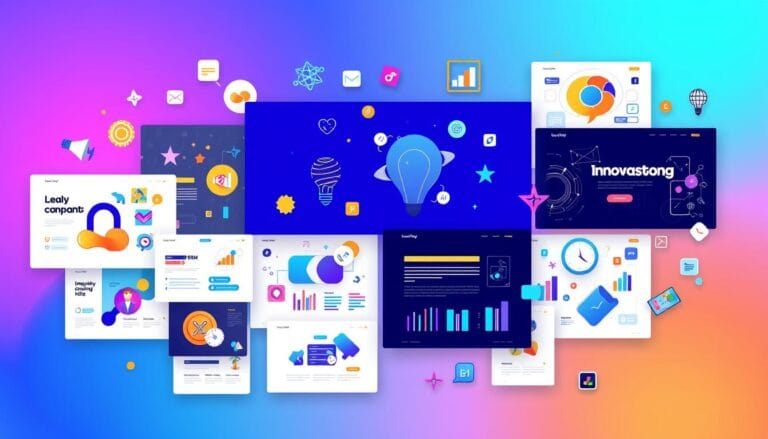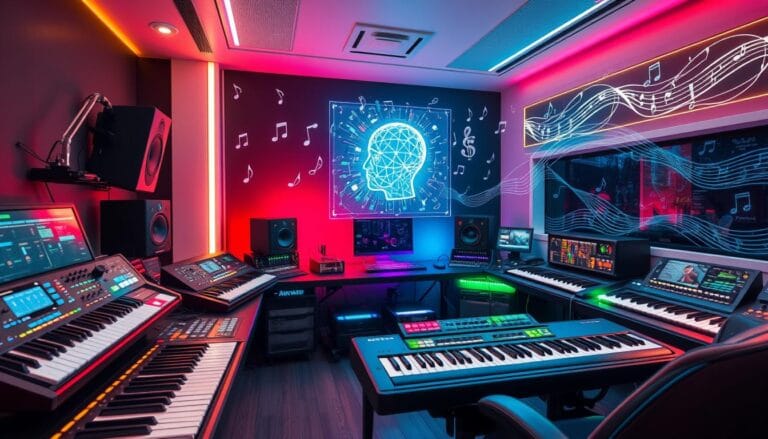Sonic Pi ChatGPT 20 Prompts to Create Amazing Music with AI
Welcome to a new journey in music creation. Sonic Pi and ChatGPT are changing how we make music. This article will show you 20 exciting prompts to use these technologies. You’ll learn to make, design, and explore music in new ways.
Thank you for reading this post, don't forget to subscribe!Sonic Pi is a tool for making music with code. ChatGPT is a smart AI language model. Together, they let you create original music, design sounds, and explore different genres. All with the help of AI.
If you love music, are starting out, or just want to see tech and creativity meet, this article is for you. It will give you the tools and knowledge for a fun musical journey. Get ready to explore new sounds and push music limits with Sonic Pi and ChatGPT.
Table of Contents
Introduction: The Future of Music Creation with AI
The music world is on the verge of a big change. This change comes from Sonic Pi and ChatGPT, two powerful tools. They are making music creation a new and exciting field, where humans and AI work together.
What Is Sonic Pi?
Sonic Pi lets people make music with code. Users can create, change, and shape sounds live. It’s a way to mix coding with creativity, leading to new musical ideas.
What Is ChatGPT?
ChatGPT is an AI that can write like a human. It’s great for many tasks, including music composition, lyric writing, and sound design. This AI tool is a big help in making music.
Why Combine Sonic Pi and ChatGPT?
Together, Sonic Pi and ChatGPT create endless possibilities. They let users explore music in new ways. This mix of code and AI helps in making music, sound design, and exploring different genres.
“The combination of Sonic Pi and ChatGPT represents a significant stride forward in the evolution of music creation, empowering artists and enthusiasts to push the boundaries of what’s possible.”
The future of music looks bright with Sonic Pi and ChatGPT. They blur the line between human and machine in music. This mix of tech promises to open up new creative paths, inspiring musicians to explore new sounds and ideas.
20 Genius Prompts to Generate Music with Sonic Pi and ChatGPT
Discover the magic of AI in music with 20 genius prompts. These prompts mix Sonic Pi and ChatGPT’s powers. They cover everything from music making to sound design, and even complex music structures. They aim to spark your creativity and explore new music production limits.
Prompts for Composition
- Start with a catchy melody in Sonic Pi. Then, ask ChatGPT to add harmonies and chord progressions.
- Let ChatGPT describe a mood or emotion. Use Sonic Pi to turn that into music.
- Work with ChatGPT on a unique rhythm. Use Sonic Pi to add complex time signatures and polyrhythms.
Prompts for Sound Design
- Ask ChatGPT to describe a new, imaginary instrument. Use Sonic Pi to create it.
- Get ChatGPT to create sound effects. Use Sonic Pi to make an ambient piece.
- Learn about synthesizing sounds from ChatGPT. Use Sonic Pi to make your own sounds.
Prompts for Genre-Specific Music
Work with ChatGPT to find the essence of a music genre. Use Sonic Pi to write a song that captures that genre’s spirit.
Creating Complex Musical Structures with AI
Use AI to explore complex music structures. Ask ChatGPT for a multi-movement composition outline. Then, use Sonic Pi to create it, trying out new patterns and algorithms.
“The combination of Sonic Pi’s programming power and ChatGPT’s creative ideation can unlock endless possibilities for musical exploration and innovation.”
Exploring Different Musical Genres with AI
Unlock the boundless potential of AI to explore a wide range of musical genres. From classical to electronic beats, jazz to hip-hop, Sonic Pi and ChatGPT help you create music beyond traditional genres.
Dive into the world of ai sound design tools and unleash your creativity. Use ChatGPT to create chatgpt music prompts for each genre. Sonic Pi’s coding interface lets you bring your ideas to life with precision.
Experiment with each genre’s unique sounds. Mix traditional instruments with free music tools to create your own unique music. Whether you’re experienced or new, Sonic Pi and ChatGPT will help you explore:
- Classical and orchestral compositions
- Mesmerizing electronic soundscapes
- Soulful jazz and blues improvisation
- Infectious hip-hop beats and grooves
- Emotive folk and acoustic arrangements
- Pulsating rock and metal compositions
Unlock the boundless potential of AI-driven music creation. Start a musical journey with no limits. Let Sonic Pi and ChatGPT guide you through exploring different musical genres, redefining sound possibilities.
“The future of music is a fusion of human creativity and AI-powered innovation. Embrace the power of Sonic Pi and ChatGPT to explore new sonic frontiers and push the boundaries of what’s possible in music.”
Advanced Sound Design and Effects
In music creation, Sonic Pi and ChatGPT open up endless possibilities. They let you create new sounds and effects. This way, your music can reach new heights.
With ChatGPT, you can make your own synthesizers and effects. This lets you shape your music exactly how you want. You can use AI to create unique sounds that make your music stand out.
Sonic Pi and ChatGPT work together in amazing ways. They let you build complex effects chains. Imagine adding AI-generated reverbs or filters to your music. The possibilities are endless.
Exploring AI sound design opens up a world of creativity. You can make everything from cinematic soundscapes to futuristic textures. With these tools, you can do things in music that were never possible before. Let your imagination run wild and see what you can create with Sonic Pi and ChatGPT.
“The future of music is not just about playing notes, but about sculpting sound itself. With AI-driven tools, the possibilities for sonic exploration are truly limitless.”

| AI Sound Design Tool | Description | Pricing |
|---|---|---|
| Sonic Pi | A powerful, open-source live coding environment for creating music and sound effects using code | Free to use |
| ChatGPT | An advanced language model that can assist with a wide range of tasks, including sound design and music composition | Free to use, with paid plans available |
| Magenta | A collection of open-source machine learning models and tools for generating music and art | Free to use |
| Amper Music | An AI-powered music composition platform that allows you to create custom music and sound effects | Subscription-based, with plans starting at $9.99 per month |
Integrating ChatGPT-Generated Lyrics with Sonic Pi
The world of music is changing fast. Now, tools like ChatGPT and Sonic Pi are working together. This lets you create music in new ways, making your songs come alive.
ChatGPT can write lyrics that match your music perfectly. It uses smart tech to make words that touch your listeners’ hearts. You can tell stories or share deep thoughts through your songs.
To start, try different ChatGPT music prompts. These prompts help ChatGPT write lyrics that fit your music style. You can make everything from slow songs to upbeat hits.
After you get your ChatGPT-generated lyrics, you’ll need to mix them with Sonic Pi. You’ll learn how to make the words fit your music and add voices. It’s all about understanding Sonic Pi and matching the words with the music.
When you mix ChatGPT’s words with Sonic Pi’s sounds, you make free music that’s special. This mix of AI and music lets you create songs that feel real and touch people’s hearts.
Exploring this mix of ChatGPT and Sonic Pi opens up endless possibilities. You can make music that’s never been heard before. It’s a chance to express yourself in new and exciting ways.
Troubleshooting Common Issues and Solutions
Starting your journey with code to music and using free music tools like Sonic Pi and ChatGPT can be exciting. But, you might face some common problems. Don’t worry, we’ve got you covered. This section will help you solve these issues easily.
Common Coding Issues in Sonic Pi
Syntax errors are a common problem for Sonic Pi users. These errors can mess up your sonic pi chatgpt 20 prompts and affect your music. Sonic Pi’s error messages can guide you to fix these issues.
- Focus on the error message and the line where it happens.
- Check your code for any mistakes in commands, parameters, or punctuation.
- Look up Sonic Pi’s documentation or online resources for coding tips.
How to Debug Errors in Real-Time Coding
Sonic Pi’s real-time coding is amazing, but debugging can be tough. Here are some tips to help:
- Use Sonic Pi’s live logging to see your code’s output and find errors.
- Try adding
putsstatements to print variable values and follow your program’s flow. - Use Sonic Pi’s GUI to get visual cues about your code’s timing and structure.
Tips on Improving the Performance of Your Music
As you make more complex music with Sonic Pi and ChatGPT, you might run into performance problems. Here are some tips to improve your music’s performance:
| Tip | Description |
|---|---|
| Reduce Sonic Pi synth complexity | Make your synth settings simpler or use less demanding synths to reduce CPU load. |
| Manage sample playback | Play fewer samples at once and optimize how you load samples. |
| Optimize code structure | Make your code more efficient by reducing unnecessary work. |
By tackling these common problems and using these solutions, you’ll be able to create great music with Sonic Pi and ChatGPT.

Building Complete Musical Compositions
Making a full musical piece is exciting and rewarding. AI tools like Sonic Pi and ChatGPT make it easier. They open up new musical worlds and let you bring your ideas to life.
Begin by using ChatGPT to create initial ideas, melodies, and chord progressions. This AI tool gives you a solid base. Then, use Sonic Pi to refine and expand on these ideas.
- Use ChatGPT to come up with the main melodies and chords. Try out different styles and genres.
- With Sonic Pi, turn these ideas into real music. Add more instruments, rhythms, and changes in sound.
- Play with Sonic Pi‘s huge sound library. Find unique sounds and textures for your music.
- Use Sonic Pi to shape your music’s structure and flow. Make sure it all fits together well.
By using Sonic Pi and ChatGPT together, you can create amazing music. These AI tools help you explore new ideas and bring your vision to life. Dive into the world of how to make music with chatgpt and sonic pi chatgpt 30 prompts.
“The true sign of intelligence is not knowledge but imagination.”
– Albert Einstein
The journey of making music is just as important as the final song. Enjoy the process, try new things, and let AI tools help you create your free music masterpiece.
Song Structure Development
Making catchy song structures is key in music making. AI tools like ChatGPT make this easier. They help you try out new song forms, from simple to complex.
ChatGPT brings fresh ideas to the table. It offers free music tools and code to music ideas. These can spark your creativity and help you try new things.
- Verse-Chorus Structures: ChatGPT helps with catchy verse-chorus patterns. It suggests lyrics, melodies, and chords for a memorable song.
- Bridges and Transitions: ChatGPT helps you smoothly move between song parts. It suggests bridges or interludes to add depth.
- Instrumental Sections: ChatGPT gives ideas for instrumental parts. This can show off your skills and add excitement to your song.
- Nonlinear Structures: ChatGPT lets you try complex song structures. This can make your music more interesting and unpredictable.
Using ChatGPT music prompts opens up new possibilities. It helps you create more engaging and innovative songs.
| Metric | Value |
|---|---|
| Frequency of user interactions over a span of 22 days | 100 entries |
| Distribution of user comments and replies within the thread | Users like `sveltejs` and `winstonjs` have multiple entries |
| Time intervals between user responses | N/A |
| Engagement patterns among users in the discussion | Svelte projects dominate the list with entries like `svelte-dnd-action` and `kit` |
| Participation levels of users in the conversation | The project `winston` has 22946 counts, and `react-beautiful-dnd` stands out with 33426 entries |
| Trends in user contributions over time | N/A |
| Interactions of users at different hierarchical levels (e.g., parents, roots) | N/A |
| Analysis of user engagement across various segments of the thread | N/A |
| Depth of engagement based on replies received by each user | N/A |
“Embracing the creative potential of AI tools like ChatGPT can unlock new possibilities in your song structure development, leading to more innovative, engaging, and captivating musical compositions.”
Arrangement Techniques
Exploring AI music creation with Sonic Pi and ChatGPT is exciting. Learning arrangement techniques is key to making your music sound professional. These ai sound design tools help you create music that grabs your audience’s attention.
Final Production Tips
Here are some tips to make your music stand out:
- Try sound layering: Mix different AI sounds and effects for depth. See how different sounds work together.
- Make your music move: Use Sonic Pi and ChatGPT for changing melodies and chords. Add ups and downs to keep it interesting.
- Refine your mix: Adjust the sound levels and placement of AI sounds. Use mixing tricks to make it sound polished.
- Add your own touch: Even with AI, your personal style matters. Add your own music or small changes to make it yours.
By using these tips, you can make your create music and sound effects for free sound amazing. AI helps, but your creativity is what makes it special.
| Technique | Description | Example Applications |
|---|---|---|
| Sound Layering | Combining multiple AI-generated sounds and effects to create depth and complexity in your arrangements. | Layering a Sonic Pi-generated bassline with a ChatGPT-composed melody and AI-designed sound effects to create a rich, multilayered track. |
| Dynamic Progressions | Utilizing Sonic Pi and ChatGPT to generate evolving and captivating melodic and harmonic progressions. | Generating a ChatGPT-inspired chord progression that builds in complexity and intensity, then using Sonic Pi to create a corresponding rhythmic and melodic accompaniment. |
| Mixing and Polishing | Refining the balance, volume, and spatial positioning of AI-generated elements to create a cohesive and professional-sounding mix. | Employing Sonic Pi’s mixing features to adjust the levels, panning, and effects of various AI-produced sounds, creating a polished and well-balanced final production. |
| Human Touch | Incorporating your own musical touches, such as live instrumentation or subtle manual adjustments, to infuse your personal style and character into the final production. | Recording a live guitar or piano performance and seamlessly integrating it with the AI-generated elements, creating a hybrid composition that blends technology and human artistry. |
By exploring these sonic pi chatgpt 20 prompts and techniques, you can unlock the full potential of AI-powered music creation. You’ll make music that amazes with its depth, movement, and creativity.
Conclusion
Exploring Sonic Pi and ChatGPT shows us how music creation is changing with AI. The 30 prompts we’ve looked at are just the start. They show the endless possibilities when you mix Sonic Pi’s coding with ChatGPT’s language skills.
AI tools like these are changing how we create music. They let musicians and producers do things they never thought possible. By using Sonic Pi and ChatGPT, you can make unique music, design sounds, and create new genres.
Starting to make music with Sonic Pi and ChatGPT is just the first step. As humans and machines work together in music, new and exciting things will happen. Dive into the 30 prompts and see what amazing music you can make with AI’s help.
FAQ
What is Sonic Pi?
What is ChatGPT?
Why combine Sonic Pi and ChatGPT?
What are some common coding issues in Sonic Pi?
How can ChatGPT-generated lyrics be integrated with Sonic Pi compositions?
How can AI be used to develop song structures?
What are some advanced arrangement techniques and final production tips for Sonic Pi and ChatGPT-generated music?
Source Links
Sonic Pi Official Documentation: Comprehensive guides and tutorials on using Sonic Pi for music creation. Available at sonic-pi.net.
OpenAI API Documentation: Explore OpenAI’s API capabilities for creative AI applications at OpenAI API Documentation.







